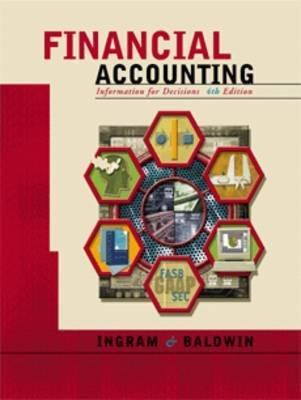Question
1. Which of the following best describes the statement of cash flows as it relates to the other financial statements? A. The Statement of Cash
1. Which of the following best describes the statement of cash flows as it relates to the other financial statements? A. The Statement of Cash Flows includes the beginning and ending balances in cash, which flow to the balance sheet. B. The Statement of Cash Flows describes the differences between: a) the change in cash flows during the accounting period; and b) net income as reported in the income statement C. The Statement of Cash Flows contains information about the different classification of activities (e.g., operating, investing, financing) that flow to the changes in retained earnings on the retained earnings statement D. Both A & B E. All of the Above
2. Which of the following would not belong on the Income Statement? A. Service Revenue B. Net Income C. Deferred Revenue D. Both A & B E. Both B & C
3. Which of the following best represents the accounting equation for a business with the following balance sheet items: Cash $ 50,000 Common Stock $ 10,000 Accounts Payable $ 75,000 Retained Earnings: $ 12,000 Long-term Debt $ 25,000 Accounts Receivable $ 70,000 Dividends: $ 2,000 A. The accounting equation does not hold because total assets of $120,000 do not equal the sum of total liabilities and stockholders equity of $124,000. B. The accounting equation does not hold because total assets of $125,000 do not equal the sum of total liabilities and stockholders equity of $119,000. C. The accounting equation does not hold because total assets of $120,000 do not equal the sum of total liabilities and stockholders equity of $119,000. D. The accounting equation does hold because total assets of $120,000 equals the sum of total liabilities and stockholders equity of $120,000. E. None of the Above
4. Which of the following best describes how to record the following transaction: December 31st: Recording $4,000 of depreciation expense relating to a delivery truck. A. Debit Depreciation Expense & Credit Accumulated Depreciation - Truck since the expense is incurred during the year and the book value of the truck has decreased. B. Debit Depreciation Expense & Credit Fixed Asset Truck since the expense is incurred during the year and the book value of the truck has decreased. C. Debit Accumulated Depreciation & Credit Depreciation Expense since the expense is incurred during the year and the book value of the truck has decreased. D. Debit Fixed Asset Truck & Credit Depreciation Expense since the expense is incurred during the year and the book value of the truck has decreased. E. None of the above best describe the transaction.
5. Which of the following does not represent a current liability? A. Accounts Payable due within 90 days B. Accounts Receivable due within 90 days C. The current portion of long term-debt due within 1 year. D. Both A & B E. Both B & C Prompt #1 [2.5 points] (1) On December 12, 2023, the Senior Accountant for AirFrance asks you how to record the $100,000 cash received from customers for flights to and from France in May 2024. Provide the necessary journal entry for the date the cash was received. (2) Which accounting principle dictates which account should be credited in the above transaction? How so?
Prompt #2 [5 points] Lena starts a graphic design company on October 1, 2023. For each of the below transactions occurring in 2023, provide the necessary T-Accounts (with final balances) to document the transaction from the business perspective. September 1, 2023: Lena invests $50,000 Cash into the business in exchange for Common Stock. December 14, 2023: Purchased supplied expenses of $1,000 with a promise to pay later.
Extra Credit [1 point] 1. Which of the following best describes the following transaction? September 31st: Paid rent of $7,500 in cash for the month of October. A. Assets do not change, liabilities do not change, and expenses do not change. B. Assets do not change, liabilities increase, and expenses increase. C. Assets decrease, liabilities do not change, and expenses decrease. D. Assets increase, liabilities increase, and expenses increase. E. Assets decrease, liabilities decrease, and expenses decrease.
Step by Step Solution
There are 3 Steps involved in it
Step: 1

Get Instant Access to Expert-Tailored Solutions
See step-by-step solutions with expert insights and AI powered tools for academic success
Step: 2

Step: 3

Ace Your Homework with AI
Get the answers you need in no time with our AI-driven, step-by-step assistance
Get Started


